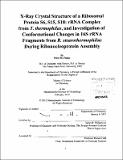| dc.contributor.advisor | James R. Williamson. | en_US |
| dc.contributor.author | Funke, Peter M | en_US |
| dc.contributor.other | Massachusetts Institute of Technology. Dept. of Chemistry. | en_US |
| dc.date.accessioned | 2012-09-27T15:28:21Z | |
| dc.date.available | 2012-09-27T15:28:21Z | |
| dc.date.copyright | 2012 | en_US |
| dc.date.issued | 2012 | en_US |
| dc.identifier.uri | http://hdl.handle.net/1721.1/73391 | |
| dc.description | Thesis (S.M.)--Massachusetts Institute of Technology, Dept. of Chemistry, 2012. | en_US |
| dc.description | Cataloged from PDF version of thesis. | en_US |
| dc.description | Includes bibliographical references (p. 74-80). | en_US |
| dc.description.abstract | The X-ray crystallographic structure of a fragment of the 30S ribosomal subunit from Thermus thermophilus containing ribosomal proteins S6, S15, S18, and a minimal rRNA binding site (T4 RNP) containing two different three-helix junctions was solved to 2.6 A. The protein S15 contains four bundled a-helices and binds the rRNA along the minor groove of helix 22 and contacts elements of both three-helix rRNA junctions. The protein S6 contains a four-stranded [beta]-sheet buttressed by two a-helices and forms a heterodimer with S18, a poorly structured protein with both a-helices and random coil elements. The S6:S18 heterodimer binds across the helix 22, helix 23, helix 23a RNA junction and makes no direct contacts to S15. Time-resolved fluorescence resonance energy (trFRET) methods were used to assess conformational changes in both RNA three-helix junctions in separate model systems from Bacillus stearothermophilus. Helix 21 and helix 23 are shown to stack coaxially onto each end of helix 22 in the absence of either S15 or divalent magnesium ions. S15 and magnesium are both shown to stabilize a reorganization of the helix 20, helix 21, helix 22 RNA junction, whereby helix 20 rotates proximal to helix 22. Single-pair fluorescence resonance energy transfer (spFRET) methods were used to show a conformational change in individual RNA molecules in solution upon addition of either S15 or magnesium. We also observe individual subpopulations of unbound and bound RNA as we titrate S15 around the known protein dissociation constant Kd. We incorporate our structural information into a more detailed model of cooperative binding between S15 and the S6:S18 heterodimer during T4 RNP formation, and address the implica | en_US |
| dc.description.statementofresponsibility | by Peter M. Funke. | en_US |
| dc.format.extent | 80 p. | en_US |
| dc.language.iso | eng | en_US |
| dc.publisher | Massachusetts Institute of Technology | en_US |
| dc.rights | M.I.T. theses are protected by
copyright. They may be viewed from this source for any purpose, but
reproduction or distribution in any format is prohibited without written
permission. See provided URL for inquiries about permission. | en_US |
| dc.rights.uri | http://dspace.mit.edu/handle/1721.1/7582 | en_US |
| dc.subject | Chemistry. | en_US |
| dc.title | X-Ray crystal structure of a ribosomal protein S6, S15, S18 : rRNA complex from T. thermophilus, and investigation of conformational changes in 16S rRNA fragments from B. stearothermophilus during ribonucleoprotein assembly | en_US |
| dc.title.alternative | Ribosomal ribonucleic acid complex from T. thermophilus, and investigation of conformational changes in 16S rRNA fragments from B. stearothermophilus during ribonucleoprotein assembly | en_US |
| dc.type | Thesis | en_US |
| dc.description.degree | S.M. | en_US |
| dc.contributor.department | Massachusetts Institute of Technology. Department of Chemistry | |
| dc.identifier.oclc | 809933429 | en_US |
